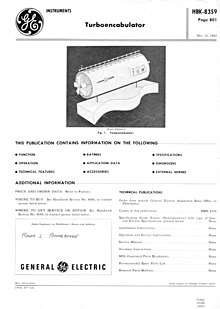Turboencabulator
The turboencabulator (in later incarnations the retroencabulator or Micro Encabulator) is a fictional machine whose technobabble description is an in-joke among engineers.
The following quote is from the original 1944 Students' Quarterly Journal article by "J. H. Quick".[1]
The original machine had a base plate of prefabulated amulite, surmounted by a malleable logarithmic casing in such a way that the two main spurving bearings were in a direct line with the panametric fan. The latter consisted simply of six hydrocoptic marzlevanes, so fitted to the ambifacient lunar waneshaft that side fumbling was effectively prevented. The main winding was of the normal lotus-o-deltoid type placed in panendermic semi-boloid slots in the stator, every seventh conductor being connected by a nonreversible tremmie pipe to the differential girdlespring on the "up" end of the grammeters.
History


The original technical description of the "turbo-encabulator" was written by British graduate student John Hellins Quick (1923-1991). It was published in 1944 by the British Institution of Electrical Engineers Students' Quarterly Journal[2] as also noted by consulting firm Arthur D. Little in a 1995 reprint of Quick's description, and giving Quick's full name.[3]
The earliest written U.S. source may have been in 1946, in an Arthur D. Little Industrial Bulletin. An early popular American reference to the turbo-encabulator appeared in an article by New York lawyer Bernard Salwen in Time on April 15, 1946. Part of Salwen's job was to review technical manuscripts. He was amused by the jargon and passed on the description from the Arthur D. Little pamphlet.[1]
Time got with the gag, featuring the device in a May 6, 1946 issue, described as "An adjunct to the turbo-encabulator, employed whenever a barescent skor motion is required."[4] A month later a response to reader mail on the feature appeared in the June 3, 1946 issue:
If the sackful of mail we have received from you is any indication, the story of "The Turbo-Encabulator in Industry" struck many a responsive chord. Aside from those of you who wanted to be reassured that TIME hadn't been taken in, we received the customary complaints about using too much technical jargon for the layman, observations such as "My husband says it sounds like a new motor; I say it sounds like a dictionary that has been struck by lightning"; suggestions that it "might have come out of the mouth of Danny Kaye," and plaintive queries like: "Is this good?" Wrote one bemused U.S. Navyman: "It'sh poshible." To some the turbo-encabulator sounded as though it would be a "wonderful machine for changing baby's diapers." A reader from Hoboken assumed that it would be on sale soon in Manhattan department stores. Many of you wrote in to thank us for illuminating what you have long wanted to tell your scientist friends."[5]
In 1962 a turboencabulator data sheet was created by engineers at General Electric's Instrument Department, in West Lynn, Massachusetts. It quoted from the previous sources and was inserted into the General Electric Handbook.[6] The turboencabulator data sheet had the same format as the other pages in the G.E. Handbook. The engineers added "Shure Stat" in "Technical Features", which was peculiar only to the Instrument Department, and included the first known graphic representation of a "manufactured" Turboencabulator using parts made at the Instrument Department.
In c. 1977 Bud Haggart, an actor who appeared in many industrial training films in and around Detroit, performed in the first film realization of the description and operation of the "Turboencabulator", using a truncated script adapted from Quick's article. Bud convinced director Dave Rondot and the film crew to stay after the filming of an actual GMC Trucks project training film to realize the Turboencabulator spot.[7]
In c. 1988 the Chrysler Corporation "manufactured" the Turboencabulator in a video spoof, with Haggart reprising his role from the GM film.[8] Rockwell Automation "manufactured" the renamed Retro-Encabulator in another video spoof in c. 1997.[9] On April Fools' Day 2013, Hank Green released a SciShow episode on YouTube entitled "The Retro-Proto-Turbo-Encabulator."[10] On April 1, 2016, PATH "introduced" the Micro-Encabulator on their YouTube Channel as a "new game-changing global health technology featuring hydrocoptic miniaturization and advanced panametric fam alignment."[11]
April 2020 Viper Innovations continued this historic gag with a presentation of the Turbo Encabulator 2.0 with quantic IoT.[12]
References
- Salwen, Bernard (15 April 1946). "For Nofer Trunnions". Time.
- Quick, J.H. (1944). "The turbo-encabulator in industry". Students' Quarterly Journal. 15 (58): 22. doi:10.1049/sqj.1944.0033.
- adl.com
- "Letters, May 6, 1946". Time. May 6, 1946. Retrieved March 8, 2011.
- "Letters, Jun. 3, 1946". Time. June 3, 1946. Retrieved March 8, 2011.
- Turboencabulator.
- "Turbo Encabulator" the Original. Retrieved 2013-12-24.
- Chrysler Turbo Encabulator. Chrysler Corporation. Retrieved 2013-12-24.
- Rockwell Retro Encabulator. Rockwell Automation. Retrieved 2013-12-24.
- April Fools Episode - The Retro-Proto-Turbo-Encabulator. Hank Green. 2013-04-01. Retrieved 2013-12-24.
- PATH (2016-04-01), Introducing the innovative new Micro Encabulator™, retrieved 2017-01-11
- Turbo Encabulator 2.0, 2020-04-01, retrieved 2020-04-01
External links
- The first realization of the Turboencabulator (16mm with Bud Haggart) on YouTube
- The complete Chrysler video (with Bud Haggart) on YouTube
- Dodge video - 1997 (With Bud Haggart and Tony) on YouTube
- Turbo Encabulator Rockwell video (with Bud Haggart) on YouTube
- Complete Retro-Encabulator Rockwell video on YouTube
- Version done by a real GE engineer on YouTube
- The Turbo-encabulator in Industry
- Retroencabulator website (contains Turbo-Encabulator text with "Turbo" replaced by "Retro"; does not contain the text from the Retro-Encabulator video)
- An Interview with actor Mike Kraft who starred in several videos, including the Chrysler one, playing the service instructor and a late Rockwell remake (available on his own site) Kraft even has vague plans of filming a retroencabulator sequel.
- Turboencabulator.info -- Turboencabulator Information Website a collection of all known Turboencabulator and Retroencabulator information.
- The PATH Micro Encabulator™ - Introduced 1/1/2016 on YouTube
- Turbo Encabulator 2.0 with Quantic IoT
- Big Data Encabulator